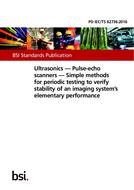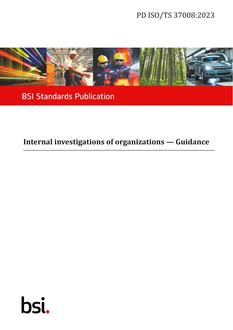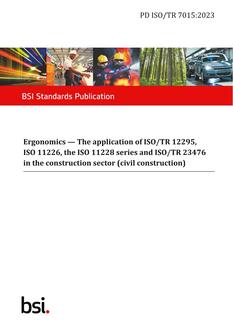
BS PD IEC/TS 62736:2016
Click here to purchase
This document specifies requirements and methods for periodic testing of the quality ofdiagnostic medical ultrasound systems with linear array, curved linear array, single element,annular array, phased array, matrix linear array transducers and two-dimensional arrays.Image interpretation and measurement workstations are included. Usually, “periodic testing” isreferred to here as “quality control”. This document represents a minimum set of such testsintended for frequent users of medical ultrasound systems, for quality control professionals intheir organization, or those hired from other quality-control and/or service-providerorganizations. System-manufacturing and repair companies might well employ other oradditional tests. The tests are defined in three levels, with the simplest and most costeffectiveperformed most frequently, similarly to [1]. More complete tests for acceptancetesting and for assessment at times of particular importance or concern are specified inIEC 61391-1, IEC 61391-2 and IEC TS 62791 [15]. These more complete tests arecategorized as performance evaluation, rather than quality control or frequent periodic testing.
This document also defines terms and specifies methods for measuring (for qualitymaintenance or quality control) the maximum relative depth of penetration of real-timeultrasound B-MODE scanners, though this penetration measure is listed as less frequentlyapplied.
Frequent distance-measurement accuracy tests are recommended only for certain classes ofposition encoding that are not now known to be highly stable and without bias.
The types of transducers used with these scanners include:
- mechanical probes;
- electronic phased arrays;
- linear arrays;
- curved arrays;
- two-dimensional arrays;
- three-dimensional scanning probes based on a combination of the above types.
Transducers not readily amenable to transducer-element testing by the simple imageuniformityprocedures specified (for example, phased array and 2D-array transducers) aretested only partially by maximum relative depth of penetration. System manufacturers areencouraged to provide pulsing patterns of the transducer elements to allow testing ofindividual elements or small-enough groups of elements to enable users to detect significantelement failure or to provide access to another implemented and explained element-testprogram. Dedicated Doppler systems are excluded from coverage here as specializedequipment is required to test them. This test equipment can be specific to the intendedapplication of the Doppler system.
All scanners considered include basic pulse-echo techniques. The failures to be detected bythe recommended pulse-echo tests also will affect the operation of other modes, such ascolour-flow, harmonic-, elasticity- and compound imaging. The test methodology is applicablefor transducers operating in the 1 MHz to 17 MHz frequency range and could be madeapplicable up to 40 MHz, if the depth of penetration were allowed to be relative, rather thanabsolute, and phantom stability were verified [15]. Image-uniformity QC is applicable totransducers operating in the 1 MHz to 40 MHz frequency range as the requirements forphantoms are not stringent.
NOTE Phantom manufacturers are encouraged to extend the frequency range to which phantoms are specified toenable relative depth-of-penetration tests of systems operating at fundamental and harmonic frequencies above17 MHz.
Cross References:
IEC 60050-802
IEC 61391-1
IEC 61391-2
IEC TS 62791
IEC TS 61390:1996
IEC TS 62558
IEC 62563-1
All current amendments available at time of purchase are included with the purchase of this document.
Product Details
- Published:
- 07/31/2016
- ISBN(s):
- 9780580762901
- Number of Pages:
- 42
- File Size:
- 1 file , 4.4 MB
- Product Code(s):
- 30250928, 30250928, 30250928
- Note:
- This product is unavailable in United Kingdom


